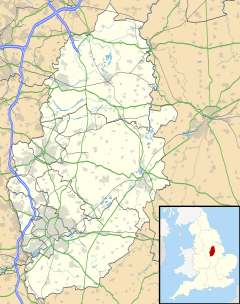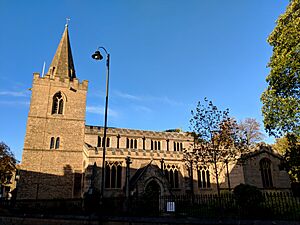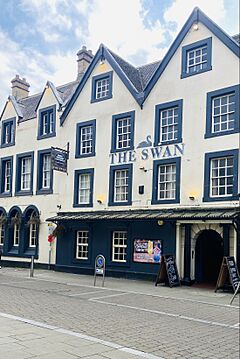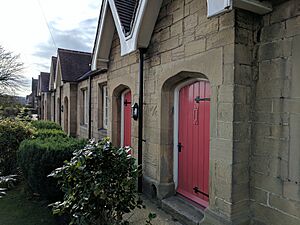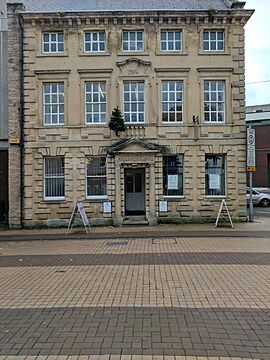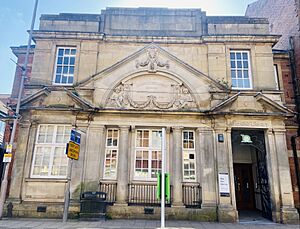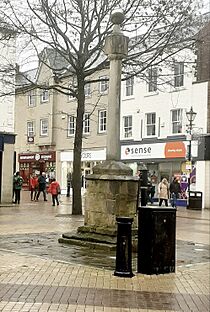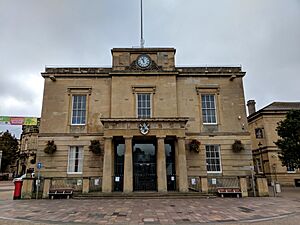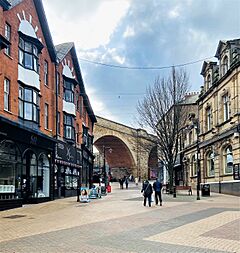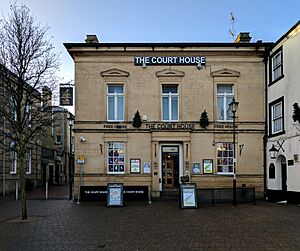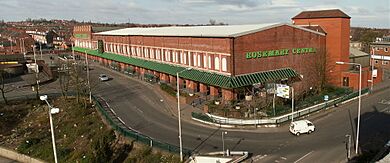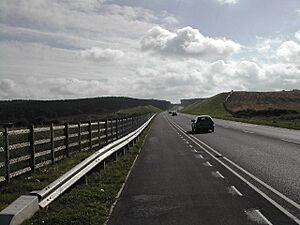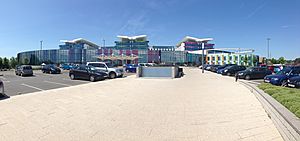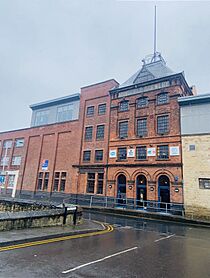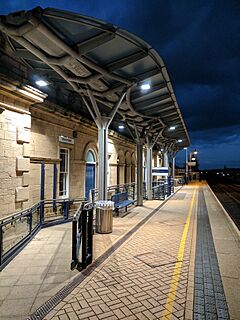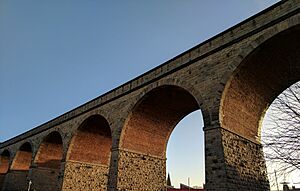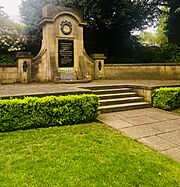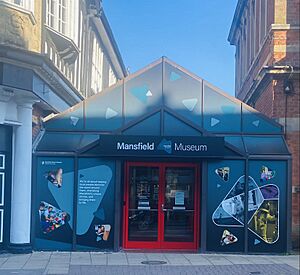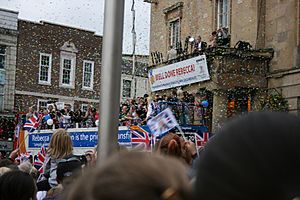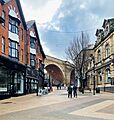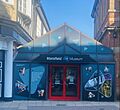Mansfield facts for kids
Quick facts for kids Mansfield |
|
|---|---|
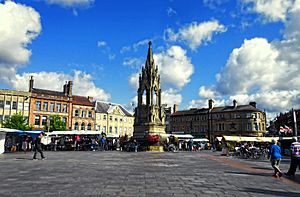 Mansfield Market Place and Cavendish Monument |
|
| Population | 110,500 |
| OS grid reference | SK 53745 61114 |
| • London | 140.9 miles |
| District |
|
| Shire county | |
| Region | |
| Country | England |
| Sovereign state | United Kingdom |
| Post town | MANSFIELD |
| Postcode district | NG18, NG19 |
| Dialling code | 01623 |
| Police | Nottinghamshire |
| Fire | Nottinghamshire |
| Ambulance | East Midlands |
| EU Parliament | East Midlands |
| UK Parliament |
|
Mansfield is a busy market town in Nottinghamshire, England. It's the main town in the Mansfield District and the second largest place in Nottinghamshire, after the city of Nottingham. Mansfield became a market town in 1227, which means it was given special permission to hold markets. The town is located in the Maun Valley, about 12 miles north of Nottingham. In 2021, about 110,500 people lived there. Mansfield is also special because it's the only place in Nottinghamshire with a mayor chosen by public vote.
Contents
- What's in a Name? The Story of Mansfield's Name
- Mansfield Through Time: A Journey into History
- Places of Worship: Mansfield's Churches
- Mansfield's Economy: Shops, Services, and More
- Getting Around: Transport in Mansfield
- Sports and Recreation in Mansfield
- Green Spaces: Parks and Nature
- Remembering Loved Ones: Cemeteries and Crematorium
- Fun and Entertainment in Mansfield
- Mansfield in the Media
- Mansfield in Books
- Famous People from Mansfield
- Mansfield's Twin Towns
- Mansfield's Weather
- Images for kids
- See also
What's in a Name? The Story of Mansfield's Name
Historians aren't completely sure how Mansfield got its name. One idea is that it was named after a noble family called Mansfield, who came to England with King William the Conqueror. Another thought is that the name comes from an old Anglo-Saxon word, "Manson," which means traffic, combined with "field," meaning a place of trade. This would suggest it was a busy trading spot. A third idea is that it was named after the River Maun, which flows through the town.
Mansfield Through Time: A Journey into History
Early Days: From Romans to Medieval Kings
People have lived in Mansfield since Roman Britain times. In 1787, a Roman villa (a large country house) was found nearby. Later, in 1849, many Roman silver coins were discovered near King's Mill.
Mansfield was once a "Royal Manor," meaning it belonged to the King. King Edward the Confessor owned land here in 1042. Later, William the Conqueror also owned parts of Mansfield. In 1066, he made Sherwood Forest a special hunting ground for the royal family.
Kings often visited Mansfield. Henry II of England stayed at King's Mill, and King John visited so often between 1200 and 1216 that he built a home here. Later, King Edward I even held an important meeting in the town.
The Domesday Book, a famous survey from 1086, recorded the town as Mammesfeld. Later, in 1227, market papers called it Maunnesfeld. By 1377, when King Richard II allowed a four-day fair each year, the name was Mannesfeld.
Parts of King John's Palace from the 12th century can still be seen near Clipstone, between Mansfield and Edwinstowe. This was a place where royal families and important people would relax. It was here that King William the Lion of Scotland met King Richard I of England (Richard the Lionheart) after his return from the crusades.
St Peter and St Paul's Church is mentioned in the 1086 Domesday Book. It was given by King William II to the bishop of Lincoln in 1092.
A special plaque and tree in the town centre mark the spot believed to be the old centre of Sherwood Forest. This plaque was updated in 2005.
Tudor and Stuart Times: New Ideas and Old Buildings
In 1516, during King Henry VIII's reign, the Manor of Mansfield was given to Thomas Howard, 3rd Duke of Norfolk. It later passed to other noble families.
Dame Cecily Fogan, in 1521, left a lot of land to Mansfield's church and community in her will.
In the 16th and 17th centuries, travellers could stop at several old inns in Mansfield. The Swan, which still exists today, has a stone dating back to 1490. Many other old timber-framed buildings were taken down over the years to make way for new developments.
In the 1640s, George Fox lived in Mansfield and worked as a shoemaker. Mansfield became the birthplace of the Quaker religion after Fox had a special experience near St Peter and St Paul's Church. He felt he needed to share his ideas with others. This happened during the time of the English Civil War. Today, there's a Quaker Heritage Trail in the town. Fox later met Elizabeth Hooton nearby, who is thought to be the first person to follow Quaker beliefs.
The Old Meeting House (a Unitarian church) on Stockwell Gate was built in 1702. It's the oldest nonconformist (non-Church of England) place of worship in Nottinghamshire. Its history goes back to 1666, when eight Presbyterian ministers found safety in Mansfield.
In 1691, Elizabeth Heath started the Almshouses to provide homes for poor people. Six homes were for Quakers and six for members of the main Church.
The 18th and 19th Centuries: Growth and Change
In 1709, Samuel Brunt left money to help the poor people of Mansfield. Later, Faith Clerkson (1725) and Charles Thompson (1784) also gave money to educate children. This led to the start of the Brunt's Charity, which helped people in need.
Robert Dodsley, a famous publisher, was once a stocking weaver in Mansfield. He wrote a play called The King and the Miller of Mansfield. He also helped publish Dr Samuel Johnson's famous dictionary.
The Moot Hall in Mansfield Market Place was built in 1752 by Henrietta Harley.
In 1777, the Mansfield Workhouse, which housed poor people, was on Nottingham Road. It later moved to Stockwell Gate and could hold 300 people.
In 1790, a writer named John Throsby described Mansfield as a "flourishing and genteel market town" that was "generally well built."
In 1851, a monument called the Bentinck Memorial (also known as the Cavendish Monument) was put up in the Market Place. It honours Lord George Bentinck.
In 1894, William Horner Groves called Mansfield "one of the quaintest and most healthy of the towns in the Midland counties."
The 20th Century: Modern Times
The Carnegie Old Library on Leeming Street was built in 1905 with money from Andrew Carnegie, a rich businessman who helped many communities. In the same year, Mansfield got a tram system, which ran until 1932.
Mansfield's Old Markets
Mansfield is a historic market town with a market tradition that goes back over 700 years. A special Royal charter was given in 1227, allowing the market to operate. The main market square you see today was created after older buildings were removed in 1823. In the middle of the square is the Bentinck Memorial, built in 1849, which remembers Lord George Bentinck.
The nearby Buttercross Market in West Gate used to be a cattle market. Its stone centrepiece is from the 16th century. Mansfield Library, opened by Queen Elizabeth II in 1977, is also nearby.
Places of Worship: Mansfield's Churches
St Peter and St Paul's Church is a very old and important building, listed as Grade I. It's mentioned in the Domesday Book from 1086 and was mostly built by the Normans. St Johns Church, built in 1854, is a Grade II listed building. St Mark's Church (1897) and St Lawrence the Martyr Church (1909) are also Grade II listed.
St Philip Neri Church is a Roman Catholic Church. There is also a Quaker Meeting House on Rosemary Street.
Mansfield's Economy: Shops, Services, and More
Town Centre Activities
Mansfield has a large market place that is the heart of its shopping and business area. You can find a museum, the Palace Theatre, restaurants, and shops here.
The council plans to buy and improve the old Beale's store in the town centre. This project, called Mansfield Connect, aims to bring more people and businesses to the area. In 2023, the UK government agreed to give £20 million for this project.
Also, Severn Trent Water is investing £76 million to help prevent flooding in the town. This includes creating "rain gardens" around the Market Place and a small park for children.
Since 2010, Mansfield has had a Business Improvement District (BID). This means local businesses pay a small extra amount to help improve the town centre. The BID helps with events, security, and making shop fronts look better. They even installed free Wi-Fi in the town centre in 2013.
Shopping in Mansfield
One of Mansfield's main shopping areas is the Four Seasons shopping centre, built between 1973 and 1976. It has over 50 shops.
The Rosemary Centre, which used to be a large weaving factory, was turned into shops in 1984. There are also three outdoor retail parks with more shops and fast-food places. Plans were approved in 2023 to replace the Rosemary Centre with a Lidl supermarket and another shop.
The East Midlands Designer Outlet is also close to Mansfield.
Council and Community Services
The main offices for the Mansfield District Council are at the Civic Centre on Chesterfield Road South. This building was specially built in 1986 and opened by Princess Anne in 1987. It brings together many council services in one place.
The Civic Centre also houses the Job Centre Plus, which helps people find work. There's also a Mansfield Community Partnership, which brings together police, street wardens, and other services to help keep the town safe.
The council plans to create a new community hub at the old town hall in the town centre. This project is part of the government's "Levelling Up" scheme.
Town Improvements and History
More people are moving to Mansfield from London than to any other part of Nottinghamshire. Many new homes and developments are being built or planned, like High Oakham Park and the Lindhurst development, which will include 1700 homes, a hotel, a health centre, and a primary school.
Several projects to improve Mansfield were planned but delayed due to money issues. However, some projects have been completed, like Arrival Square (an office block) and Queen's Place (shops and offices). In 2019, Mansfield received £25 million from the UK Towns Fund to help with regeneration.
King's Mill Hospital nearby has been rebuilt. The MARR road (Mansfield and Ashfield Regeneration Route), a bypass around the town, opened in 2004. It helps reduce traffic in the town centre and connects different areas. In 2009, Mansfield tried to become a city, but it wasn't successful.
Past Industries: Brewing and Mining
Mansfield Brewery was once the UK's largest independent brewery. It was bought in 1999, and production stopped in 2002. The site is now being redeveloped into housing.
In the 1980s, Mansfield Bitter beer was famous for its funny adverts, like one showing US President Ronald Reagan with the slogan: "He might be president of the most powerful nation on earth... but he's never had a pint of Mansfield."
Mansfield also had a soft drink company called R. L. Jones, known for Sunecta and Mandora drinks. It was bought by Mansfield Brewery and later by A. G. Barr, the company that makes Irn-Bru. Production stopped in 2011.
After the brewery buildings were taken down in 2008, the land was empty for a while. It's now a housing development. The old brewery office building, Chadburn House, is now used for offices and a small brewery with a cafe.
Although Mansfield itself didn't have coal mines, many nearby areas did. Coal mining was the main industry for much of the 20th century. A difficult time for miners was the UK miners' strike (1984–1985). Many miners in Mansfield voted against the strike, but some still joined to support others. The Coal Authority, which deals with mining issues, is based in Mansfield. A large statue called Tribute to the British Miner was put up in 2003 to honour the town's mining history.
As less coal was needed, Mansfield's mines closed, and miners had to find new jobs. The tall structures above the mines, called headstocks, near Clipstone, are an important local landmark. Community groups are trying to save them to remember the area's mining past.
Getting Around: Transport in Mansfield
Train Travel
Mansfield railway station is on the Robin Hood Line. This line connects Mansfield with Nottingham and Worksop. It opened in 1995. Trains usually run once an hour in each direction.
Mansfield used to have two train stations: Mansfield Town and Mansfield Central. Both closed to passengers by 1964, leaving Mansfield without a passenger train service until 1995. For a while, Mansfield was one of the largest towns in Britain without a train station.
The railway viaduct (a bridge with arches) in White Hart Street, built in 1875, is a Grade II listed building.
Road Connections
The M1 motorway is west of Mansfield, making it easy to travel north or south. The A60 road runs through Mansfield, connecting it to Nottingham and Worksop. The A617 road goes around the town, linking it to Newark-on-Trent to the east and Chesterfield and the M1 to the west. The A38 road also ends in Mansfield, providing a direct link to Derby.
Bus Services

Buses in Mansfield are mainly run by Stagecoach from Mansfield bus station. Other companies like Trent Barton and National Express also operate here.
The current bus station opened in 2013 near the railway station. It replaced an older bus station from 1977.
Sports and Recreation in Mansfield

Mansfield is home to Mansfield Town FC, a football team known as the Stags or yellows. They returned to the Football League in 2013 and were promoted to League One (the third tier) in April 2024. Another local football club, AFC Mansfield, plays in the Forest Town area.
Mansfield Rugby Club plays rugby union at Eakring Road. They have won the Notts Cup many times.
The Mansfield Giants are Mansfield's main Basketball Club. They play in the England Basketball league.
Mansfield used to host an annual half marathon for over 30 years, until 2011.
Angling (fishing) is popular in the Mansfield area, where there are still ponds from the old textile factories.
Tennis is played at Mansfield Lawn Tennis Club, which has been at the same site since 1883. There are also tennis courts in six Mansfield District Council parks.
Mansfield is also home to Mansfield Roller Derby, a Flat Track Roller Derby league.
Mansfield does not have a central Leisure Centre. The old one was sold to Tesco, which built a large store there in 2007. The council received money for the site and used it to improve Sherwood Baths instead.
Mansfield has two indoor swimming centres and a smaller pool at a school. These facilities mean Mansfield has a lot of indoor water-sports space for its size. The town is also a training centre for the Nottinghamshire County Council Swim Squad. The Rebecca Adlington Swimming Centre at Sherwood Swimming Baths has a 25-metre pool and a special training pool. It uses eco-friendly heating systems.
At the Beijing 2008 Olympic Games, Mansfield's own Rebecca Adlington won two gold medals in swimming. When she returned home, thousands of people lined the streets to welcome her. Her success encouraged many young people in the area to start swimming. At the 2012 Olympic Games, she won two bronze medals. She stopped competitive swimming in 2013.
The Water Meadows swimming complex has a gym, a soft-play area for children, a cafe, a 25-metre competition pool, and other pools. The leisure lagoon pool has a wave machine and a slide, making it popular with families.
Mansfield Bowling Club has been around since the 1700s. The club moved to new facilities at Queen Elizabeth's Academy in 2009.
Green Spaces: Parks and Nature

Titchfield Park, next to the Water Meadows swimming complex, has large grassy areas on both sides of the River Maun. It has a bowls green, tennis courts, a basketball court, and a children's play area.
Fisher Lane Park is popular for dog walking and kite flying. It also has a concrete skate park. In summer, you might find children's rides here.
Carr Bank Park has a rocky grotto, a bandstand, and pretty flower beds. It also has a war memorial made of local stone, honouring soldiers who died in wars since the end of the Second World War.
Mansfield is only a few miles from Sherwood Forest, which is famous for its connection to Robin Hood. In West Gate, there's a tree and a plaque marking what was once the centre of Sherwood Forest. Nearby is a large metal feather sculpture from 2007, called A Spire for Mansfield.
Remembering Loved Ones: Cemeteries and Crematorium
Mansfield's main cemetery and crematorium are on a 10-acre site on Derby Road. The cemetery opened in 1857 because there wasn't enough space in church graveyards. It was extended in 1898. This cemetery contains the graves of 51 Commonwealth service personnel from World War I and 45 from World War II.
The Mansfield and District Crematorium opened in 1960. It has two chapels and is managed by Mansfield District Council and other local councils.
There are also other cemeteries in nearby areas like Mansfield Woodhouse and Pleasley Hill.
Fun and Entertainment in Mansfield
The Palace Theatre on Leeming Street is the town's main place for shows. It was built as a cinema in 1910 and later became a live theatre. It hosts professional and amateur plays, and a yearly pantomime.
Mansfield Museum, next to the Palace Theatre, opened in 1904. It's free to enter and won an award for being a family-friendly museum in 2011.
Mansfield used to have a famous nightclub called Venue 44, where the superclub Renaissance started in the 1990s. The building was taken down in 2010.
The old Carnegie Library building, from 1905, became an arts and performance centre in 1976. It has a recording studio and a small theatre. Mansfield also has a large Odeon Cinemas outside the town centre.
Mansfield Super Bowl, a 28-lane bowling alley, opened in 1991. It was refurbished in 2015.
Some live music venues in Mansfield have closed over the years, like The Intake and the Town Mill.
Summer in the Streets Festival
Every year, from June to August, Mansfield District Council holds a Summer in the Streets festival. This includes many public events around the town, like children's entertainment, fairground rides, and workshops.
The festival usually ends with a big event in Titchfield Park called Party in the Park. It features live music from local bands and dance groups.
In 2010, the Irish boy band Westlife performed live at Field Mill stadium, the home of Mansfield's football team. This was a big event for the town.
Mansfield in the Media
The local newspapers are the Chad and the Mansfield and Ashfield News Journal.
Radio stations include Mansfield 103.2, BBC Radio Nottingham, and Capital Midlands.
Local television news is provided by BBC East Midlands Today and ITV News Central.
Mansfield in Books
Robert Dodsley's 1737 play King and the Miller of Mansfield is set in the town. In 1928, the writer D. H. Lawrence described Mansfield in his book Lady Chatterley's Lover as a "disheartening colliery town."
Famous People from Mansfield
Many notable people have connections to Mansfield:
- Rebecca Adlington (born 1989), an Olympic gold and bronze medallist swimmer.
- Richard Bacon (born 1975), a well-known broadcaster.
- John Balance (1962–2004), a singer and musician.
- Kris Commons (born 1983), a footballer who played for Celtic F.C.
- Robert Dodsley (1704–1767), a playwright and poet.
- Ed Davey (born 1965), a British politician and leader of the Liberal Democrats.
- Ric Lee (born 1945) and Leo Lyons (born 1943), musicians from the band Ten Years After.
- Jack Manifold, an internet personality known for streaming Minecraft.
- John Ogdon (1937–1989), a famous pianist.
- Carly Paoli (born 1989), an opera singer.
- Tom Scott, a popular YouTuber and former TV presenter.
- Alvin Stardust (1942–2014), a pop singer.
- James Graham (playwright), a British playwright and screenwriter.
Mansfield's Twin Towns
Mansfield is twinned with several towns and cities around the world:
- Heiligenhaus, Germany
- Mansfield, Massachusetts, United States
- Mansfield, Ohio, United States
- Reutov, Russia
- Stryi, Ukraine
Mansfield's Weather
Mansfield has a mild climate, meaning it doesn't get too hot or too cold. Rainfall is spread out evenly throughout the year, and it can often be breezy. The closest weather station is in Warsop, about seven miles north of Mansfield.
The highest temperature ever recorded in the area was 34.6°C (94.3°F) in August 1990. The lowest was -19.1°C (-2.4°F) in January 1987. On average, there are about 59 nights a year when the temperature drops below freezing.
Mansfield gets about 634 mm (25 inches) of rain each year, with rain falling on about 113 days.
| Climate data for Warsop, elevation: 46 m (151 ft), 1971–2000 normals, extremes 1960–2006 | |||||||||||||
|---|---|---|---|---|---|---|---|---|---|---|---|---|---|
| Month | Jan | Feb | Mar | Apr | May | Jun | Jul | Aug | Sep | Oct | Nov | Dec | Year |
| Record high °C (°F) | 14.4 (57.9) |
17.7 (63.9) |
22.2 (72.0) |
25.3 (77.5) |
27.0 (80.6) |
31.6 (88.9) |
32.5 (90.5) |
34.6 (94.3) |
27.9 (82.2) |
23.9 (75.0) |
18.0 (64.4) |
15.0 (59.0) |
34.6 (94.3) |
| Mean daily maximum °C (°F) | 7.2 (45.0) |
7.1 (44.8) |
10.0 (50.0) |
12.4 (54.3) |
16.2 (61.2) |
19.1 (66.4) |
21.8 (71.2) |
21.3 (70.3) |
18.0 (64.4) |
13.8 (56.8) |
9.4 (48.9) |
7.9 (46.2) |
13.7 (56.7) |
| Daily mean °C (°F) | 3.8 (38.8) |
3.9 (39.0) |
6.1 (43.0) |
7.8 (46.0) |
10.9 (51.6) |
13.8 (56.8) |
16.1 (61.0) |
15.7 (60.3) |
13.2 (55.8) |
9.8 (49.6) |
6.1 (43.0) |
4.6 (40.3) |
9.3 (48.7) |
| Mean daily minimum °C (°F) | 0.4 (32.7) |
0.6 (33.1) |
2.2 (36.0) |
3.2 (37.8) |
5.6 (42.1) |
8.4 (47.1) |
10.4 (50.7) |
10.1 (50.2) |
8.4 (47.1) |
5.8 (42.4) |
2.8 (37.0) |
1.3 (34.3) |
4.9 (40.8) |
| Record low °C (°F) | −19.1 (−2.4) |
−15.6 (3.9) |
−13.9 (7.0) |
−6.7 (19.9) |
−3.9 (25.0) |
−1.7 (28.9) |
1.4 (34.5) |
−0.1 (31.8) |
−3.2 (26.2) |
−6.6 (20.1) |
−8.4 (16.9) |
−15.2 (4.6) |
−19.1 (−2.4) |
| Average precipitation mm (inches) | 56.2 (2.21) |
42.5 (1.67) |
48.6 (1.91) |
53.3 (2.10) |
48.6 (1.91) |
60.8 (2.39) |
43.9 (1.73) |
48.6 (1.91) |
54.1 (2.13) |
56.2 (2.21) |
51.8 (2.04) |
63.1 (2.48) |
633.9 (24.96) |
| Average precipitation days (≥ 1.0 mm) | 10.7 | 8.7 | 10.6 | 9.4 | 8.7 | 9.2 | 7.2 | 8.3 | 8.2 | 9.8 | 10.0 | 11.5 | 113.0 |
| Source: KNMI | |||||||||||||
Images for kids
See also
 In Spanish: Mansfield para niños
In Spanish: Mansfield para niños


